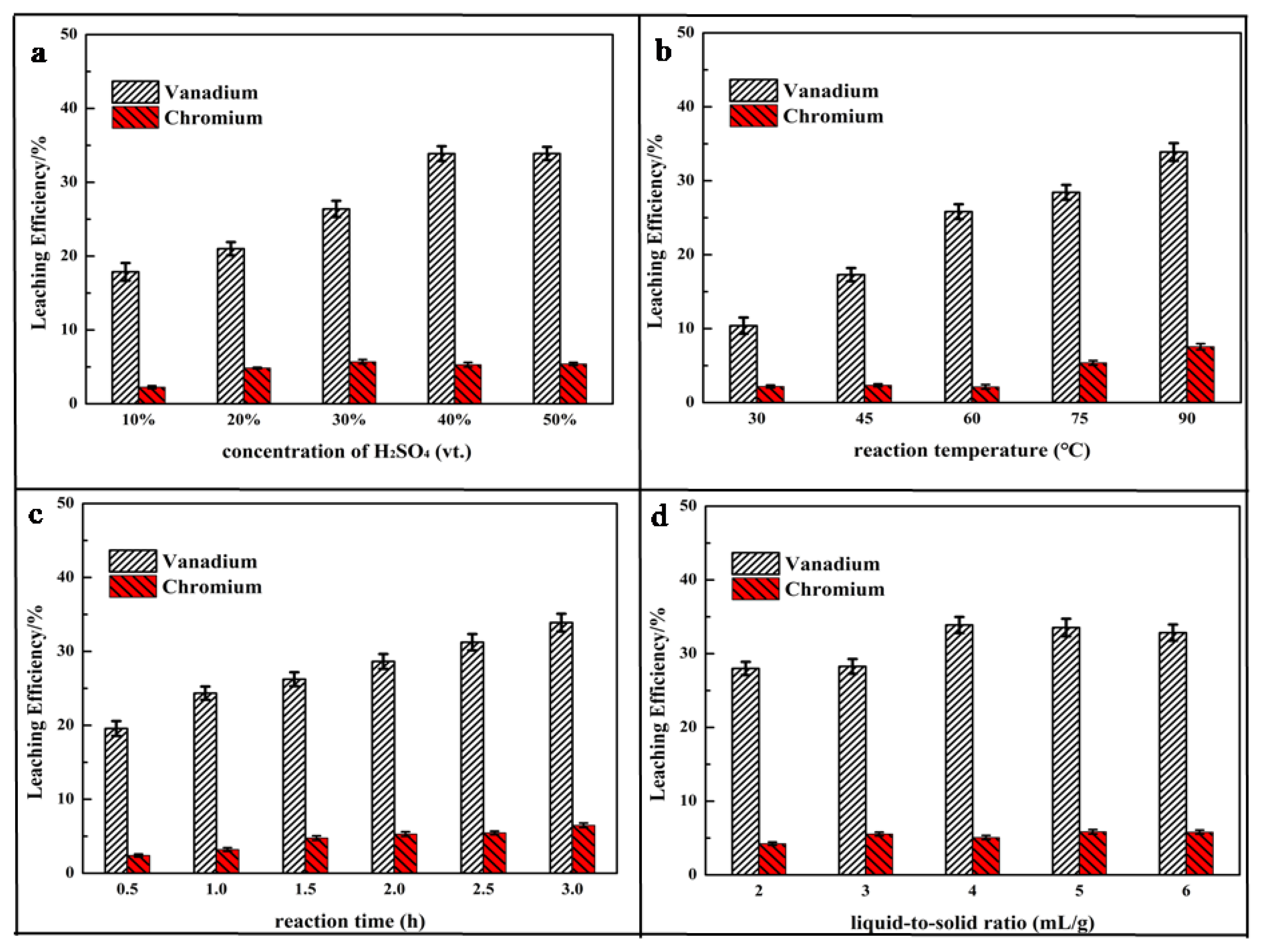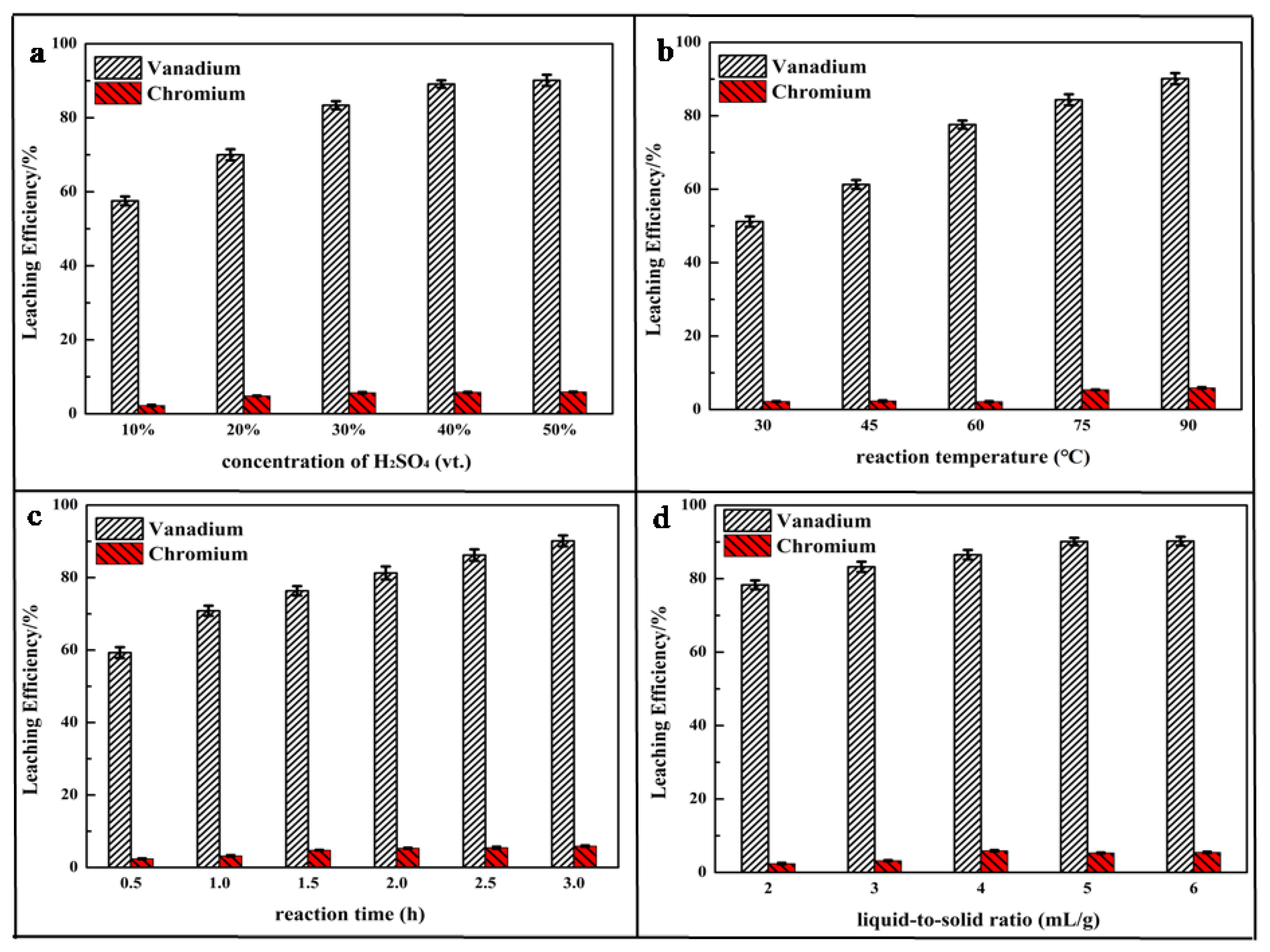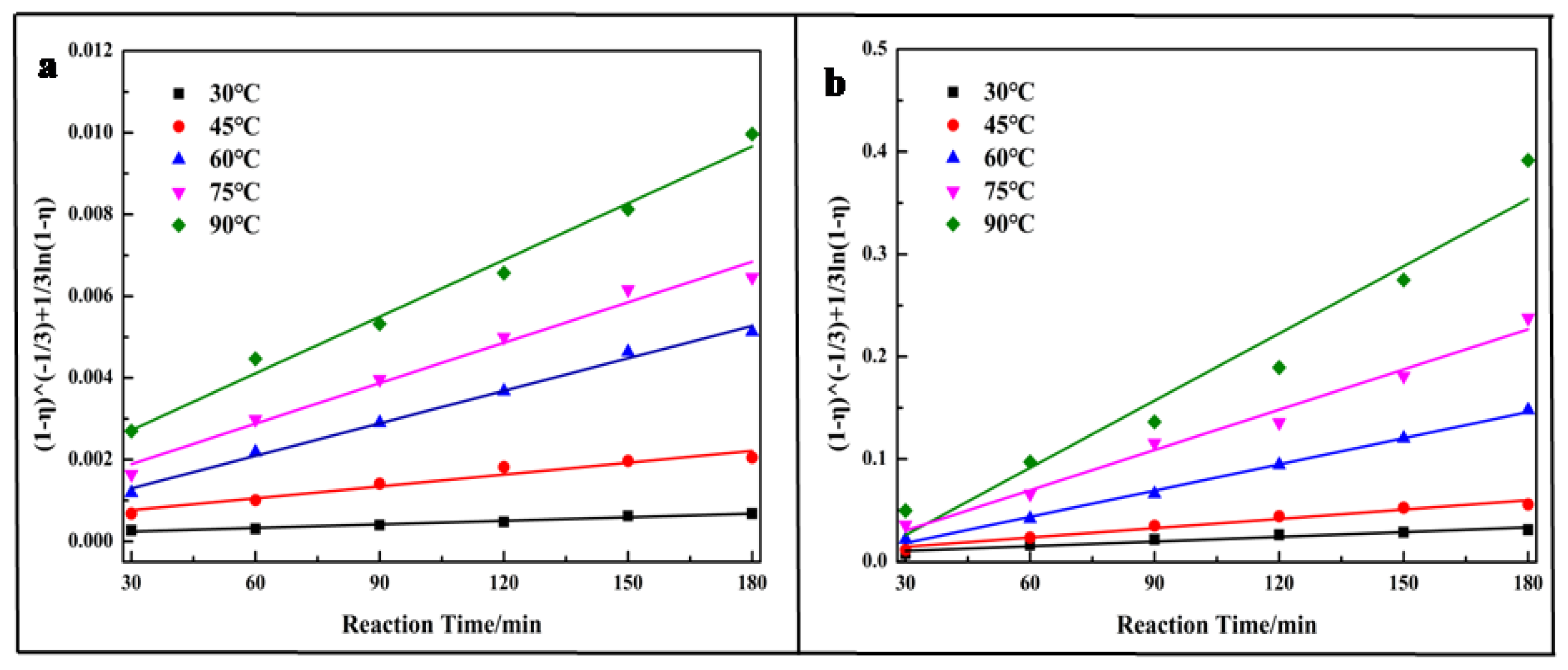Efficient Recovery of Vanadium from High-Chromium Vanadium Slag with Calcium-Roasting Acidic Leaching
Abstract
:1. Introduction
2. Materials and Methods
2.1. Materials
2.2. Experimental Procedure
2.3. Analytical Methods
2.4. Characterization
3. Results
3.1. Characterization of HCVS
3.2. Direct-Acid-Leaching Process
3.3. Characterization of Roasting HCVS
3.4. Acid Leaching for Roasting HCVS
3.5. Leaching Kinetics
4. Conclusions
- (1)
- The chromium and vanadium existed as spinel structure in the HCVS, which are too stable to destroy directly; only 33.89% of vanadium and 7.56% of chromium could be leached out at the selected conditions during the direct acid leaching process: reaction time of 3 h, liquid-to-solid ratio at 4:1 mL/g, concentration of H2SO4 at 40 vt.%, reaction temperature of 90 °C, and stirring rate at 500 rpm. The Ea of the vanadium leached out was 62.98 kJ/mol, which indicates that the vanadium was hard to leach out directly;
- (2)
- Most low valence vanadium could be oxidized to high valence during the calcium-roasting process, and the leaching efficiency could achieve 89.12% under the optimal conditions: reaction time of 3 h, liquid-to-solid ratio at 4:1 mL/g, reaction temperature of 90 °C, concentration of H2SO4 at 40 vt.%, and stirring rate at 500 rpm. The leaching behavior followed the shrinking core model well, and the controlling step was the surface chemical reaction, with an Ea of 58.95 kJ/mol for the calcium-roasting acid leaching process.
- (3)
- Chromium was hard to leach out both in the direct acid leaching process and the calcium-roasting acid leaching process; the leaching efficiency was below 8%. Higher roasting temperatures and new additive agents will be needed for efficient chromium recovery in our future works.
Author Contributions
Funding
Data Availability Statement
Conflicts of Interest
References
- Zhu, H.; Xiao, X.; Guo, Z.; Han, X.; Liang, Y.; Zhang, Y.; Zhou, C. Adsorption of vanadium (V) on natural kaolinite and montmorillonite: Characteristics and mechanism. Appl. Clay Sci. 2018, 161, 310–316. [Google Scholar] [CrossRef]
- Wei, Z.; Liu, D.; Hsu, C.; Liu, F. All-vanadium redox photoelectrochemical cell: An approach to store solar energy. Electrochem. Commun. 2014, 45, 79–82. [Google Scholar] [CrossRef]
- Nicholas, N.J.; da Silva, G.; Kentish, S.; Stevens, G.W. Use of Vanadium(V) Oxide as a Catalyst for CO2 Hydration in Potassium Carbonate Systems. Ind. Eng. Chem. Res. 2014, 53, 3029–3039. [Google Scholar] [CrossRef]
- Wen, J.; Ning, P.; Cao, H.; Zhao, H.; Sun, Z.; Zhang, Y. Novel method for characterization of aqueous vanadium species: A perspective for the transition metal chemical speciation studies. J. Hazard. Mater. 2018, 364, 91–99. [Google Scholar] [CrossRef]
- Peng, H. A literature review on leaching and recovery of vanadium. J. Environ. Chem. Eng. 2019, 7, 103313. [Google Scholar] [CrossRef]
- Yan, B.; Wang, D.; Wu, L.; Dong, Y. A novel approach for pre-concentrating vanadium from stone coal ore. Miner. Eng. 2018, 125, 231–238. [Google Scholar] [CrossRef]
- Xue, N.; Zhang, Y.; Huang, J.; Liu, T.; Wang, L. Separation of impurities aluminum and iron during pressure acid leaching of va-nadium from stone coal. J. Clean. Prod. 2017, 166, 1265–1273. [Google Scholar] [CrossRef]
- Hu, X.; Yue, Y.; Peng, X. Release kinetics of vanadium from vanadium titano-magnetite: The effects of pH, dissolved oxygen, temperature and foreign ions. J. Environ. Sci. 2018, 64, 298–305. [Google Scholar] [CrossRef]
- Wen, J.; Jiang, T.; Zhou, W.; Gao, H.; Xue, X. A cleaner and efficient process for extraction of vanadium from high chromium vanadium slag: Leaching in (NH4)2SO4-H2SO4 synergistic system and NH4+ recycle. Sep. Purif. Technol. 2019, 216, 126–135. [Google Scholar] [CrossRef]
- Wen, J.; Jiang, T.; Xu, Y.; Liu, J.; Xue, X. Efficient Separation and Extraction of Vanadium and Chromium in High Chromium Vanadium Slag by Selective Two-Stage Roasting–Leaching. Metall. Mater. Trans. A 2018, 49, 1471–1481. [Google Scholar] [CrossRef]
- Gao, H.; Jiang, T.; Xu, Y.; Wen, J.; Xue, X. Change in phase, microstructure, and physical-chemistry properties of high chromium vanadium slag during microwave calcification-roasting process. Powder Technol. 2018, 340, 520–527. [Google Scholar] [CrossRef]
- Zhang, G.; Zhang, Y.; Bao, S. The Effects of Sodium Ions, Phosphorus, and Silicon on the Eco-Friendly Process of Vanadium Precipitation by Hydrothermal Hydrogen Reduction. Minerals 2018, 8, 294. [Google Scholar] [CrossRef] [Green Version]
- Li, H.-Y.; Fang, H.-X.; Wang, K.; Zhou, W.; Yang, Z.; Yan, X.-M.; Ge, W.-S.; Li, Q.-W.; Xie, B. Asynchronous extraction of vanadium and chromium from vanadium slag by stepwise sodium roasting–water leaching. Hydrometallurgy 2015, 156, 124–135. [Google Scholar] [CrossRef]
- Qiu, S.; Wei, C.; Li, M.; Zhou, X.; Li, C.; Deng, Z. Dissolution kinetics of vanadium trioxide at high pressure in sodium hydroxide–oxygen systems. Hydrometallurgy 2011, 105, 350–354. [Google Scholar] [CrossRef]
- Cai, Z.; Zhang, Y. Phase transformations of vanadium recovery from refractory stone coal by novel NaOH molten roasting and water leaching technology. RSC Adv. 2017, 7, 36917–36922. [Google Scholar] [CrossRef] [Green Version]
- Ji, Y.; Shen, S.; Liu, J.; Xue, Y. Cleaner and effective process for extracting vanadium from vanadium slag by using an innovative three-phase roasting reaction. J. Clean. Prod. 2017, 149, 1068–1078. [Google Scholar] [CrossRef]
- Crundwell, F. The mechanism of dissolution of the feldspars: Part II dissolution at conditions close to equilibrium. Hydrometallurgy 2015, 151, 163–171. [Google Scholar] [CrossRef]
- Crundwell, F. The mechanism of dissolution of minerals in acidic and alkaline solutions: Part IV equilibrium and near-equilibrium behaviour. Hydrometallurgy 2015, 153, 46–57. [Google Scholar] [CrossRef]
- Crundwell, F. The mechanism of dissolution of minerals in acidic and alkaline solutions: Part III. Application to oxide, hydroxide and sulfide minerals. Hydrometallurgy 2014, 149, 71–81. [Google Scholar] [CrossRef]
- Crundwell, F. The mechanism of dissolution of minerals in acidic and alkaline solutions: Part II Application of a new theory to silicates, aluminosilicates and quartz. Hydrometallurgy 2014, 149, 265–275. [Google Scholar] [CrossRef]
- Zhang, Y.; Zhang, T.-A.; Dreisinger, D.; Lv, C.; Lv, G.; Zhang, W. Recovery of vanadium from calcification roasted-acid leaching tailing by enhanced acid leaching. J. Hazard. Mater. 2019, 369, 632–641. [Google Scholar] [CrossRef] [PubMed]
- Fang, D.; Liao, X.; Zhang, X.; Teng, A.; Xue, X. A novel resource utilization of the calcium-based semi-dry flue gas desulfurization ash: As a reductant to remove chromium and vanadium from vanadium industrial wastewater. J. Hazard. Mater. 2018, 342, 436–445. [Google Scholar] [CrossRef]
- Zhang, J.; Zhang, W.; Xue, Z. Oxidation Kinetics of Vanadium Slag Roasting in the Presence of Calcium Oxide. Miner. Process. Extr. Metall. Rev. 2017, 38, 265–273. [Google Scholar] [CrossRef]
- Gao, H.; Jiang, T.; Zhou, M.; Wen, J.; Li, X.; Wang, Y.; Xue, X. Effect of microwave irradiation and conventional calcification roasting with calcium hydroxide on the extraction of vanadium and chromium from high-chromium vanadium slag. Int. J. Miner. Process. 2017. [Google Scholar] [CrossRef]
- Wen, J.; Jiang, T.; Zhou, M.; Gao, H.; Liu, J.; Xue, X. Roasting and leaching behaviors of vanadium and chromium in calcification roasting–acid leaching of high-chromium vanadium slag. Int. J. Miner. Process. 2018, 25, 515–526. [Google Scholar] [CrossRef]
- Xiaoyong, Z.; Qingjing, P.; Yuzhu, O.; Renguo, T. Research on the Roasting Process with Calcium Compounds for Silica Based Vanadium Ore. Chin. J. Process Eng. 2001, 2, 189–192. [Google Scholar]
- Yue, H.-R.; Xue, X.-X.; Zhang, W.-J. Reaction Mechanism of Calcium Vanadate Formation in V-slag/CaO Diffusion System. Metall. Mater. Trans. B 2021, 52, 944–955. [Google Scholar] [CrossRef]
- Peng, H.; Guo, J.; Zhang, X. Leaching Kinetics of Vanadium from Calcium-Roasting High-Chromium Vanadium Slag Enhanced by Electric Field. ACS Omega 2020, 5, 17664–17671. [Google Scholar] [CrossRef]
- Peiyang, S.; Bo, Z.; Maofa, J. Kinetics of the Carbonate Leaching for Calcium Metavanadate. Minerals 2016, 6, 102. [Google Scholar]
- Juhua, Z.; Wei, Z.; Li, Z.; Songqing, G. Mechanism of vanadium slag roasting with calcium oxide. Int. J. Miner. Process. 2015, 138, 20–29. [Google Scholar]
- Liu, B.; Du, H.; Wang, S.-N.; Zhang, Y.; Zheng, S.-L.; Li, L.-J.; Chen, D.-H. A novel method to extract vanadium and chromium from vanadium slag using molten NaOH-NaNO3binary system. AIChE J. 2012, 59, 541–552. [Google Scholar] [CrossRef]
- Liu, H.-B.; DU, H.; Wang, D.-W.; Wang, S.-N.; Zheng, S.-L.; Zhang, Y. Kinetics analysis of decomposition of vanadium slag by KOH sub-molten salt method. Trans. Nonferrous Met. Soc. China 2013, 23, 1489–1500. [Google Scholar] [CrossRef]
- Yang, K.; Zhang, X.; Tian, X.; Yang, Y.; Chen, Y. Leaching of vanadium from chromium residue. Hydrometallurgy 2010, 103, 7–11. [Google Scholar] [CrossRef]
- Peng, H.; Yang, L.; Chen, Y.; Guo, J. A Novel Technology for Recovery and Separation of Vanadium and Chromium from Vana-dium-Chromium Reducing Residue. Appl. Sci. 2019, 10, 198. [Google Scholar] [CrossRef] [Green Version]
- Chai, L.; Yang, J.; Zhang, N.; Wu, P.J.; Li, Q.; Wang, Q.; Liu, H.; Yi, H. Structure and spectroscopic study of aqueous Fe(III)-As(V) complexes using UV-Vis, XAS and DFT-TDDFT. Chemosphere 2017, 182, 595–604. [Google Scholar] [CrossRef]
- Bunnag, N.; Kasri, B.; Setwong, W.; Sirisurawong, E.; Chotsawat, M.; Chirawatkul, P.; Saiyasombat, C. Study of Fe ions in aquamarine and the effect of dichroism as seen using UV–Vis, NIR and X-ray. Radiat. Phys. Chem. 2020, 177, 109107. [Google Scholar] [CrossRef]
- Yu, S.; Wang, B.; Pan, Y.; Chen, Z.; Meng, F.; Duan, S.; Cheng, Z.; Wu, L.; Wang, M.; Ma, W. Cleaner production of spherical nanostructure chromium oxide (Cr2O3) via a facile combination membrane and hydrothermal approach. J. Clean. Prod. 2018, 176, 636–644. [Google Scholar] [CrossRef]
- Nagaraju, G.; Chithaiahb, P.; Ashokac, S.; Mahadevaiah, N. Vanadium pentoxide nanobelts: One pot synthesis and its lithium storage behavior. Cryst. Res. Technol. 2012, 47, 868–875. [Google Scholar] [CrossRef]
- Shin, K.-H.; Jin, C.-S.; So, J.-Y.; Park, S.-K.; Kim, D.-H.; Yeon, S.-H. Real-time monitoring of the state of charge (SOC) in vanadium redox-flow batteries using UV–Vis spectroscopy in operando mode. J. Energy Storage 2019, 27, 101066. [Google Scholar] [CrossRef]
- Peng, H.; Guo, J.; Zheng, X.; Liu, Z.; Tao, C. Leaching kinetics of vanadium from calcification roasting converter vanadium slag in acidic medium. J. Environ. Chem. Eng. 2018, 6, 5119–5124. [Google Scholar] [CrossRef]
- Deng, R.; Xie, Z.; Liu, Z.; Tao, C. Leaching kinetics of vanadium catalyzed by electric field coupling with sodium persulfate. J. Electroanal. Chem. 2019, 854, 113542. [Google Scholar] [CrossRef]
- Peng, H.; Liu, Z.; Tao, C. Leaching Kinetics of Vanadium with Electro-oxidation and H2O2 in Alkaline Medium. Energy Fuels 2016, 30, 7802–7807. [Google Scholar] [CrossRef]
- Peng, H.; Yang, L.; Chen, Y.; Guo, J.; Li, B. Recovery and Separation of Vanadium and Chromium by Two-Step Alkaline Leaching Enhanced with an Electric Field and H2O2. ACS Omega 2020, 5, 5340–5345. [Google Scholar] [CrossRef] [PubMed] [Green Version]
- Wang, X.; Jia, Y.; Ma, S.; Zheng, S.; Sun, Q. Effect of mechanical activation on the leaching kinetics of niobium-bearing minerali-sation in KOH hydrothermal system. Hydrometallurgy 2018, 181, 123–129. [Google Scholar] [CrossRef]
- Luo, M.-J.; Liu, C.-L.; Xue, J.; Li, P.; Yu, J.-G. Leaching kinetics and mechanism of alunite from alunite tailings in highly concentrated KOH solution. Hydrometallurgy 2017, 174, 10–20. [Google Scholar] [CrossRef]
- Peng, H.; Guo, J.; Huang, H.; Li, B.; Zhang, X. Novel Technology for Vanadium and Chromium Extraction with KMnO4 in an Alkaline Medium. ACS Omega 2021, 6, 27478–27484. [Google Scholar] [CrossRef]






| Element | V2O5 | Cr2O3 | FeO | CaO | MgO |
|---|---|---|---|---|---|
| Percentages (%) | 9.7 | 10.2 | 24.7 | 2.8 | 13.8 |
| Element | SiO2 | Al2O3 | MnO | TiO2 | |
| Percentages (%) | 25.7 | 10.3 | 1.6 | 2.7 |
Publisher’s Note: MDPI stays neutral with regard to jurisdictional claims in published maps and institutional affiliations. |
© 2022 by the authors. Licensee MDPI, Basel, Switzerland. This article is an open access article distributed under the terms and conditions of the Creative Commons Attribution (CC BY) license (https://creativecommons.org/licenses/by/4.0/).
Share and Cite
Peng, H.; Li, B.; Shi, W.; Liu, Z. Efficient Recovery of Vanadium from High-Chromium Vanadium Slag with Calcium-Roasting Acidic Leaching. Minerals 2022, 12, 160. https://doi.org/10.3390/min12020160
Peng H, Li B, Shi W, Liu Z. Efficient Recovery of Vanadium from High-Chromium Vanadium Slag with Calcium-Roasting Acidic Leaching. Minerals. 2022; 12(2):160. https://doi.org/10.3390/min12020160
Chicago/Turabian StylePeng, Hao, Bing Li, Wenbing Shi, and Zuohua Liu. 2022. "Efficient Recovery of Vanadium from High-Chromium Vanadium Slag with Calcium-Roasting Acidic Leaching" Minerals 12, no. 2: 160. https://doi.org/10.3390/min12020160
APA StylePeng, H., Li, B., Shi, W., & Liu, Z. (2022). Efficient Recovery of Vanadium from High-Chromium Vanadium Slag with Calcium-Roasting Acidic Leaching. Minerals, 12(2), 160. https://doi.org/10.3390/min12020160







